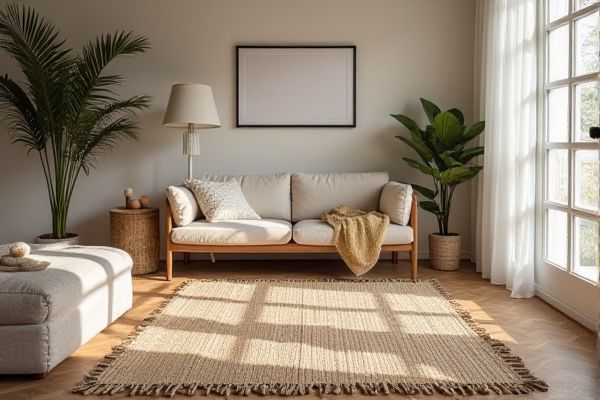
Woven rugs feature intricate, tightly interlaced fibers creating rich textures and durability, while flatweave rugs have a thinner, reversible construction crafted without knots, offering a lightweight and versatile option. Discover the key differences and decide which rug best suits your space and style by reading the rest of the article.
Table of Comparison
| Feature | Woven Rug | Flatweave Rug |
|---|---|---|
| Construction | Interlaced yarns forming a dense, plush surface | Yarns tightly woven in a flat, thin layer without pile |
| Texture | Soft, thick, and cushioned feel | Smooth, firm, and lightweight |
| Durability | High durability, suitable for heavy foot traffic | Very durable and easy to maintain |
| Maintenance | Requires regular vacuuming and occasional deep cleaning | Easy to clean; can be shaken out or spot cleaned |
| Thickness | Thicker with visible pile | Thin and flat |
| Design | Complex patterns with rich textures | Simple, geometric, or traditional patterns |
| Cost | Generally higher cost due to labor and materials | More affordable and budget-friendly |
| Use Cases | Living rooms, bedrooms, spaces needing warmth | Hallways, kitchens, high-traffic areas |
Introduction to Woven and Flatweave Rugs
Woven rugs, crafted through intricate interlacing of warp and weft threads, offer a plush texture and durable structure ideal for high-traffic areas in your home. Flatweave rugs, made on a loom without knots, boast a lightweight, reversible design with a thinner profile, making them easy to clean and perfect for layering. Understanding these differences helps you select the rug style that best complements your space's aesthetic and functional needs.
Defining Woven Rugs
Woven rugs are crafted using interlacing warp and weft threads, creating dense and textured surfaces that provide durability and intricate patterns. Unlike flatweave rugs, which lack a pile and feature a smooth, reversible design, woven rugs often incorporate raised elements or hand-knotted techniques for added depth. Your choice between woven and flatweave rugs should consider the desired texture, durability, and style for your space.
What is a Flatweave Rug?
A flatweave rug is a type of woven rug characterized by its lack of a pile, created by interlacing warp and weft threads tightly together. This weaving technique produces a lightweight, reversible rug, making it highly durable and easy to clean. Your choice of a flatweave rug offers versatility and practicality for high-traffic areas while maintaining a stylish, textured appearance.
Differences in Construction Methods
Woven rugs are created by interlacing warp and weft yarns on a loom, resulting in a denser, more textured surface that offers durability and intricate patterns. Flatweave rugs, on the other hand, use a simpler weaving technique without any pile, producing a thinner, reversible rug ideal for casual, high-traffic areas. Your choice between the two should depend on the desired texture, thickness, and ease of maintenance.
Texture and Appearance Comparison
Woven rugs feature a dense, plush texture with intricate patterns formed by interlaced fibers, offering a rich and luxurious appearance. Flatweave rugs display a smoother, thinner surface created through a weaving technique that produces reversible designs with subtle texture variations. Your choice depends on whether you prefer the tactile depth and warmth of woven rugs or the sleek, versatile look of flatweave styles.
Durability and Longevity
Woven rugs, crafted with dense, tightly interlaced fibers, offer superior durability and resist wear in high-traffic areas better than flatweave rugs. Flatweave rugs, made with a looser weave and no pile, provide lightweight durability but generally show signs of wear faster and may require more frequent replacement. Choosing a woven rug ensures long-lasting use, especially in busy household or commercial environments.
Maintenance and Cleaning Tips
Woven rugs often require gentle vacuuming and occasional professional cleaning to maintain their intricate fibers and patterns. Flatweave rugs are easier to clean with regular vacuuming and spot cleaning, making them more resistant to dirt and stains in high-traffic areas. Understanding these maintenance differences helps you select the best rug that suits your cleaning routine and lifestyle needs.
Suitability for Various Spaces
Woven rugs offer thick texture and durability, making them ideal for high-traffic areas like living rooms and hallways where cushioning and warmth are essential. Flatweave rugs, characterized by their lightweight and reversible design, work well in smaller spaces or under furniture such as dining tables, providing easy maintenance and a sleek appearance. Both rug types suit diverse environments, but woven rugs excel in cozy, high-use zones while flatweaves fit minimalist or multi-functional spaces.
Price and Value Analysis
Woven rugs typically feature intricate patterns and thicker textures, resulting in a higher price point due to the labor-intensive process and premium materials used. Flatweave rugs, created through a simpler weaving technique without pile, offer a more affordable option while maintaining durability and ease of maintenance. When evaluating price and value, flatweave rugs provide budget-friendly versatility for high-traffic areas, whereas woven rugs deliver enhanced aesthetic appeal and longevity that justify their greater investment.
Choosing Between Woven and Flatweave Rugs
Choosing between woven and flatweave rugs depends on your space's durability needs and aesthetic preferences. Woven rugs offer intricate textures and plush comfort ideal for high-traffic areas, while flatweave rugs provide a lightweight, reversible option with easy maintenance suitable for casual settings. Understanding your lifestyle and room function helps you select the rug that enhances both style and practical use.
 homyna.com
homyna.com